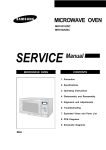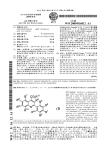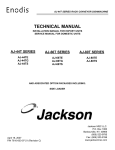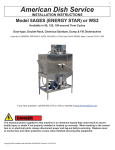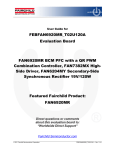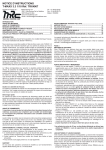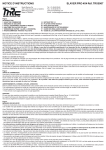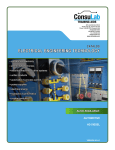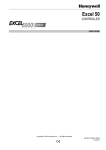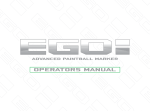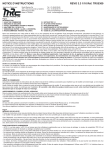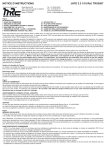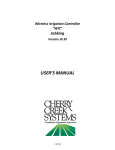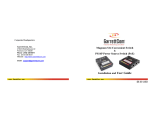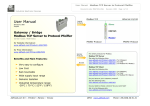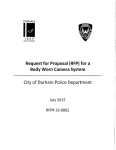Download Service, Parts, Operation, Installation & General Manual
Transcript
MODEL 24 B/BF HIGH TEMPERATURE UNIT NOVEMBER 1984 AFTER S/N 14389 BEFORE S/N 21800 INSTALLATION/OPERATION and SERVICE MANUAL INCLUDES: -Warranty Policy -Installation Requirements -Operating Instructions -Basic Functions of Dishwasher -Maintenance and Care -Wiring Diagrams -Description of Components 801 AIRPARK CENTER DRIVE NASHVILLE, TN (615)399-3944 1-800-736-8144 FAX(615)-366-9126 January 30,1998 7610-100-03-00 Rev A MANUFACTURERS WARRANTY ONE YEAR LIMITED PARTS & LABOR WARRANTY ALL NEW JACKSON DISHWASHERS ARE WARRANTED TO THE ORIGINAL PURCHASER TO BE FREE FROM DEFECTS IN MATERIAL OR WORKMANSHIP, UNDER NORMAL USE AND OPERATION FOR A PERIOD OF (1) ONE YEAR FROM THE DATE OF PURCHASE, BUT IN NO EVENT TO EXCEED (18) EIGHTEEN MONTHS FROM THE DATE OF SHIPMENT FROM THE FACTORY. Jackson MSC agrees under this warranty to repair or replace , at its discretion, any original part which fails under normal use due to faulty material or workmanship during the warranty period, providing the equipment has been unaltered, and has been properly installed, main tained and operated in accordance with the applicable factory instruction manual furnished with the machine and the failure is reported to the authorized service agency within the warranty period. This includes the use of factory specified genuine replacement parts, purchased directly from a Jackson authorized parts distributor or service agency. Use of generic replacement parts may create a hazard and void warranty certification. The labor to repair or replace such failed part will be paid by Jackson MSC, within the continental United States, Hawaii and Canada, during the warranty period provided a Jackson MSC authorized service agency, or those having prior authorization from the factory, performs the service. Any repair work by persons other than a Jackson MSC authorized service agency is the sole responsibility of the customer. Labor coverage is limited to regular hourly rates, overtime premiums and emergency service charges will not be paid by Jackson MSC. Accessory components not installed by the factory carry a (1) one year parts warranty only. Accessory components such as table limit switches, pressure regulators, pre rinse units, etc. that are shipped with the unit and installed at the site are included. Labor to repair or replace these components is not covered by Jackson MSC. This warranty is void if failure is a direct result from shipping, handling, fire, water, accident, misuse, acts of god, attempted repair by unau thonzed persons, improper installation, if serial number has been removed or altered, or if unit is used for purpose other than it was originally intended. TRAVEL LIMITATIONS Jackson MSC limits warranty travel time to (2) two hours and mileage to (100) one hundred miles. Jackson MSC will not pay for travel time and mileage that exceeds this, or any fees such as those for air or boat travel without prior authorization. WARRANTY REGISTRATION CARD The warranty registration card supplied with the machine must be returned to Jackson MSC within 30 days to validate the warranty. REPLACEMENT PARTS WARRANTY Jackson replacement parts are warranted for a period of 90 days from the date of installation or 180 days from the date of shipment from the factory, which ever occurs first. PRODUCT CHANGES AND UPDATES Jackson MSC reserves the right to make changes in design and specification of any equipment as engineering or necessity requires. THIS IS THE ENTIRE AND ONLY WARRANTY OF JACKSON MSC. JACKSON'S LIABILITY ON ANY CLAIM OF ANY KIND, INCLUD ING NEGLIGENCE, WITH RESPECT TO THE GOODS OR SERVICES COVERED HEREUNDER, SHALL IN NO CASE EXCEED THE PRICE OF THE GOODS OR SERVICES OR PART THEREOF WHICH GIVES RISE TO THE CLAIM. THERE ARE NO WARRANTIES, EXPRESSED OR IMPLIED, INCLUDING FOR FITNESS OR MERCHANTABILITY, THAT ARE NOT SET FORTH HEREIN, OR THAT EXTEND BEYOND THE DURATION HEREOF. UNDER NO CIRCUMSTANCES WILL JACKSON MSC BE LIABLE FOR ANY LOSS OR DAMAGE, DIRECT OR CONSEQUENTIAL, OR FOR THE DAMAGES IN THE NATURE OF PENALTIES, ARISING OUT OF THE USE OR INABILITY TO USE ANY OF ITS PRODUCTS. ITEMS NOT COVERED This warranty does not cover adjustments to timer cams or thermostats, cleaning wash arms or strainers, or replacement of wear items such as curtains, squeeze tubes, drain balls, door guides, or gaskets beyond 30 days from installation of unit. Also not covered are conditions caused by the use of incorrect (non commercial) grade detergents, excessive supply water temperature or pres sure, or hard water conditions. INDEX SPECIFICATIONS ELECTRICAL RATING GENERAL INSTRUCTIONS (Installation) GENERAL INSTRUCTIONS (Operation) GENERAL INSTRUCTIONS Preventive Maintenance) 2 2 3 6 7 REMOVAL of RINSE and/or WASH HEAD ASSEMBLIES (General Instructions) DEFECTIVE TIMER MOTOR 8 11 FUNCTION OF SWITCHES, CIRCUIT BREAKER and INDICATING LIGHTS REPLACEMENT OF SWITCHES la FRONT DOOR INTERLOCK SYSTEM CHECKOUT THERMOSTAT ADJUSTMENT RINSE TANK HEATER SYSTEM WASH TANK HEATER SYSTEM WATER LEVEL CONTROL SERVICE INSTRUCTIONS REPLACING SEAL AND CERAMIC for PUMP SYSTEM TROUBLE SHOOTING GUIDE PICTORIALS FRONT VIEW BACK VIEW LEFT SIDE VIEW RIGHT SIDE VIEW PAN STRAINER, VACUUM BREAKER, OVERFLOW and INCOMING PLUMBING RINSE TANK, WASH ASSEMBLY. WASH OR RINSE THERMOSTAT. WASH or RINSE THERMOMETER PUMP and MOTOR ASSEMBLY SWITCHES. DOOR SAFETY SWITCH and SAFETY SWITCH DRAIN VALVE CUTAWAY VIEW and PANEL WIRING DIAGRAMS PARTS LIST PARTS DISTRIBUTORS 12 13 14 15 16 18 19 20 21 22 25 26 27 28 29 30 31 32 33 34 36 38 SPECIFICATIONS JACKSON DISHWASHER MODEL 24 B - BP OPERATING CAPACITY 100% Racks per hour Dishes per hour 248 21 525 Glasses per hour 525 OPERATING CYCLE Wash Time — seconds Rinse Time — seconds 120 15 Total Cycle — seconds 150 WASH TANK CAPACITY (Gallons) 5.65 RINSE TANK CAPACITY (Gallons) 3 WASH PUMP CAPACITY (GPM) 60 WATER REQUIREMENTS 100% Inlet Temperature F Gallons per hour Row Pressure, PSI Row, gallons per minute Inlet size — IPS 140 deg. 52.3 20 7.1 1/2" Drain size — 0.0. 1 1/2" WASH PUMP MOTOR (HP) 1/2 WASH HEATER (kw) 1.0 RINSE HEATER (kw) 5.0 ELECTRICAL REQUIREMENTS (See below for details, under Electrical Rating) DIMENSIONS Height with Top Height with no Top Width Clearance, Wall to Machine Depth Maximum Height for Dishes 36" 34 1/2 " 24" 2 1/4" 24" 14" Rack Size 19 3/4" NOTE VENTED BACK •ALL "F" MODELS ARE FREE STANDING (Top and Side Panels) ELECTRICAL RATING MODEL VOLTS CYCLE PHASE APPROX. TOTAL LOAD AMPS 24B 220 60 1 35 Refer to 248 208 60 1 35 Machine Data 248 208/220 50 1 28 Plate Specifications subject to change without notice. GENERAL INSTRUCTIONS (INSTALLATION) Note: Read the following instruction carefully. Proper Installation of your Jackson Dishwasher will assure proper machine operation. Uncrating 24: 1. Remove straps around carton. 2. Open top flaps of dishwasher carton. 3. Remove any packing from top and sides of machine that can be done with ease from top. 4. Slide carton sleeve upward over top of dishwasher, set to one side. 5. Lift dishwasher and wooden base from carton base. 6. Move dishwasher to general installation area. 7. Remove bolts holding wooden base to machine and screw In adjustable feet supplied. 8. Reassemble wash and rinse assemblies In machine using sketch and Instructions In this manual. 9. Set dishwasher In place, ready for Installation. Note: NSF base cradle Installation must be add Installed on all AF and BF models. Cradle goes around bottom; secure la place using liquid adhesive. Installation Instructions: 1. The dishwasher can be leveled to the proper height by adjusting the adjustable feet on the four comers. The front of the unit should be 1/4" to 1/2" higher than the back. 2. Refer to the dimensional data sketch for connections. 3. The drain from the machine is a GRAVITY DRAIN SYSTEM and should, therefore, have the proper drop from the machine to the kitchen's drain system. The drain connection is located to the left rear of the machine when facing the machine's door. The drain fitting Is 1 1/2" 00 tube size, 7" from floor. 4. IMPORTANT-PLEASE READ-Located on the back upper left comer of this unit Is a steam equalizing vent. This vent in no way should be blocked off or prevented from allowing steam to be vented to the outside of the unit or from under the cabinet In which the unit Is Installed. Never pipe the steam downward toward the floor. (SEE PAGE 4 IF BEING INSTALLED UNDER A COUNTER.) 5. The electrical connections should be made to the terminal board located at the left center front. The terminals are marked LI. and NeutraL Install proper circuit breaker. wire and conduit size to conform with local and/or national codes (standards). Installation of Model 24 Top and Table gasket These Instructions are to be used for applying the adhesive backed sponge rubber strip to the top of the machine prior to setting the table in place. Included with the Model 24 table is a 6 foot length of 1/4 " thick x 1" wide sponge rubber adhesive backed stripping. Instructions for applying gasket: 1. Place one end of the tripping along the complete side of the tog support flange and cut It off. 2. Repeat the same procedure along the other side. 3. Place the remaining piece along the front edge, fit It In between the aide pieces and cut It to length. 4. Remove the backing and set the strips in place. Instructions for Installation under a porous counter top: 1. If possible, a hole should be cut through the counter top directly above the equalizing vent. A piece of 1 1/4" OD pipe Is then Inserted through the hole into the vent opening and piped to the outside. 2. If cutting a hole In the counter Is not possible, then a piece of stainless steel 36" wide by 36" long bend In the middle at 90 deg. should be centered directly over the vent to allow the steam to condensate on It when It comes out of the vent. 3. It Is very Important that this vent be kept open and cool air allowed to circulate around the unit. Installation of Model 24 Dishwasher Under Dishtable: 1. On the end of the table, locate bracket #4 opposite the sink end. 2. A square rubber gasket #3 Is supplied and should be secured to top frame of dishwasher with caulk or suitable adhesive. 3. Place dishtable #2 where It Is to be Installed and support the machine's end. 4. Slide dishwasher #1 underneath dishtable #2 so that the outside of machine Is positioned against the guide bracket #4. Make sure dishtable and dishwasher are In desired permanent location. 5. Using the two holes In bracket #4 as a guide, drill two holes 9/64" diameter In the side panel of machine. Note: Drill through first thickness of metal only. 6. Using the self-tapping screws supplied, screw them through bracket #4 and Into the side panel of machine until screws are tight Removal of Pan Strainer for Cleaning: (Wash and rinse head assemblies must be removed prior to removing strainer.) 1. Turn heat switch 'off' and drain machine by depressing drain switch for approximately 50 seconds. 2. Remove wing nut from rinse feed pipe, remove rinse head assembly by pulling forward. 3. Remove wing nut from upper pump housing, wash head may now be lifted out. 4. Pan strainer now accessible, lift out and dean thoroughly. 5. Clean around pump Intake with bristle brush. 6. Replace stainer pan. 7. Re-Install wash and rinse head assemblies. 8. Clean strainer pan daily or as needed to insure proper machine operation. Installation of Wash Head and Rinse Ann Assemblies: (Items disassembled for shipment) 1. Line holes up on wash head assembly to match slots In pump housing. 2. Insert wash head assembly down Into upper pump housing as far as possible 3. Insert retaining pin to secure wash head to pump housing. RINSE ARM ASSEMBLE 1. Line up stud to match with slot In nipple. 2. Insert rinse arm assembly into female recepticle protruding through back of machine. 3. Insert lanyard pin to secure rinse arm assembly properly. 4. Make certain end plugs are secured property In rinse tubes. GENERAL INSTRUCTIONS (OPERATION) Note: Read the following instructions carefully. Proper operation of your Jackson Dishwasher will assure clean and sanitized glasses and dishes, at optimum efficiency. Dish Preparation: 1. 2. 3. 4. Scrape dishes thoroughly. Pre-wash dishes by soaking or with hose. Place dishes and cups In dish rack, cups upside down. Place glasses and silverware la combination glass-silverware rack. glasses upside down. Scatter silverware loosely on bottom. Note: Silverware In the upright position washes and rinses better than lying flat. These silverware compartment racks an available through your dealer or Service Agency. Operators Instructions: 1. 2. 3. 4. 5. 6. 7. 8. Make sure dean pan strainer Is In place and slide empty rack In machine. Place start rocker switch In center position. Close door and lock latch. Push top of fill switch and hold approximately 45 seconds. Turn heater switch on. Open door and slide rack of dishes Into dishwasher. Dispense proper amount of detergent In machine. Start automatic wash and rinse cycle of dishwasher by pushing on top or bottom of start switch (with indicating light): light will come on. 9. When light goes out, cycle has ended, Open door, slide out rack of clean dishes to air dry, slide In rack of dirty dishes, add detergent, close door and push start switch. 10. At end of mealtime, shut off by placing start rocker switch In center position and heater switch off, Drain machine by pressing top of drain switch approximately 50 seconds, Remove pan strainer after removing lower rinse arm and wash head assembly. clean inside of machine and replace clean strainer, wash head and lower rinse arm assembly. (See page on Installation of Wash Head and Rinse Arm Assemblies — Removal of Pan Strainer for Cleaning.) Detergent Recommendations and Rinse Additives: We suggest that you contact your local Detergent Specialist for the correct detergent and rinse additives tor your area. To help you until one can be reached, we suggest that you use a nonfoaming dishwasher detergent, approximately three tablespoons in wash tank when machine Is filled and one teaspoon each cycle or load thereafter. This may have to be increased or decreased to obtain satisfactory results. GENERAL INSTRUCTIONS (PREVENTIVE MAINTENANCE) (THE FOLLOWING IS TO BE PERFORMED AS NEEDED.) Note: Read the following Instructions carefully. Proper maintenance of your Jackcon Dishwasher will ensure optimum service with a minimum of down time. 1. Remove all lime and corrosion deposits. a. Fill the machine with wash water as would ordinarily be done for washing. b. Open door and place one cup or less of de-liming compound Into the water. The compound is available from your detergent supplier. c. Turn on the manual wash switch and allow to wash for five minutes. d. Open door and examine the interior. All lime should be removed and parts should be shiny. If not, allow to wash for longer period. e. After the Interior Is dean, with door closed, empty the wash water by depressing drain switch for approximately 50 seconds. Refill machine and allow to run for two minutes, then again drain the wash reservoir. 2. Clean around overflow strainers and drain hole. a. Clean around overflow and strainer pan. b. Clean around pump Intake (toothbrush makes excellent tool for cleaning). 3. Clean Y-strainer on Incoming water line. (Water to machine must be turned off for this operation) a. Remove plug and clean strainer. 4. Clean rinse tubes. a. Remove rinse assembly by disconnecting rinse feed pipe and removing end plugs on lower rinse. b. Clean all rinse tubes and feed pipes with special brush supplied. c. If spray holes in the rinse tubes are clogged, they may be cleaned with a pointed object 5. Clean wash head assembly. a. Loosen two wing nuts holding wash head assembly to pump. b. Clean assembly at sink by flushing water through spray jets. c. If spray jets are still plugged, use sharp object to dislodge and flush again. d. Reinstall wash and rinse assemblies. (See page with Instructions.) 6. Clean any deposits which may have built up on exterior moving parts. a. Clean around door gasket. b. Using a soft bristle brush, clean around switches on exterior of control panel. (Use no water.) c. Use soft bristle brush, dip in wash tank water and scrub inside door around gasket and hinges. Use clean cloth or paper towel to wipe off loose residue. REMOVAL of RINSE and/or WASH HEAD ASSEMBLIES (GENERAL INSTRUCTIONS) 1. Before opening the door, hold the drain switch in and drain all of the water out of the unit 2. Open the door and allow the unit a few minutes to cool off. 3. With your fingers, loosen the wing nut holding the rinse feed pipe. When it is loose, pull the feed pipe out of the nipple and lay It to one side. 4. Locate Allen head set screw in the wash head cap, Insert Allen wrench and loosen screw by turning counterclockwise. 5. Turn wash head cap counterclockwise until cap Is removed and put cap In safe place. 6. Remove 1/4" stainless ball bearings carefully and put it in a receptacle In a safe place. 7. Life and remove small manifold with short tubes. Put It In a safe place. 8. Remove 1/4" ball bearing In similar method to step 16. 9. Lift and remove large manifold with large length tubes similar to step #7. 10. The lower fixed race may be left in place. 11. Clean ball bearings by soaking in de-liming solution. 12. Ball bearing race ways may be cleaned by either brushing with de-liming solution (toothbrush makes excellent tool) or gently clean by rubbing with fine sandpaper or emery cloth. 13. Rinse ball bearings and manifolds thoroughly. 14. To reassemble, first fill lower race to capacity with 1/4" ball bearings, then remove one. This will give proper movement needed during rotation of assembly. 15. Replace lower manifold and fill race fully with 1/4" ball bearings. Repeat, removing one only. 16. Replace upper manifolds and repeat necessary parts of step #14. 17. Replace wash cap by screwing on center shaft clockwise, finger tight. 18. Back off wash cap about 1/4 turn and tighten Allen set screw. 19. Rotate manifolds in opposite directions: see If they rotate freely. A rule of thumb Is to select the longest tube in the bottom manifold and make sure It moves up and down at least V and no more than 1/4". 20. Replace the rinse assembly and pipe by aligning the stud on the feed pipe with the slot in the nipple. Push the feed pipe in gently as far as It will go and then secure It with the wing nut. 21. Close the front door and refill dishwasher. 22. Run through several cycles and recheck wash arms for easy movement. Adjust if necessary. ITEM 1. 2. 3. P/N 0186500 0187000 0194004 4. 0189000 5. 0189500 DESCRIPTION WASH HEAD CAP WITH RACE WASH HEAD CAP SET SCREW WASH HEAD BEARING 1/4" S/S WASH HEAD SMALL MANIFOLD w/TUBES WASH HEAD LARGE MANIFOLD w/TUBES ITEM P/N DESCRIPTION 6. 7. 0187500 0193600 WASH HEAD CENTER SHAFT WASH HEAD FIXED RACE 8. 0188600 WASH HEAD SHAFT HOLDING PIN 9. 0109501 10. 0189805 UPPER PUMP HOUSING WASH HEAD ASSEMBLY RETAINING PIN w/RING ITEM P/N DESCRIPTION ITEM P/N DESCRIPTION 1. 2. 0125200 0126800 RINSE HEAD ARM RINSE HEAD END PLUGS 3. 0126000 RINSE HEAD NYLATRON WASHER 5. 6. 7. 0126500 0137301 6137200 RINSE HEAD SNAP RINGS S/S RINSE FEED PIPE LANYARD PIN RINSE FEED PIPE (LOWER) 8. 0137202 RINSE FEED PIPE NIPPLE 4. 0125500 RINSE HEAD HEX BRUSHING S/S TIMER for MODEL 24 DISHWASHERS General Description The timer is a self-contained (frame mounted) timer of the repeating cycle type. It is mounted on the control panel of Jackson Automatic Dishwashing Machines, to control the automatic functions of these -machines. It consists of a dock motor which operates on 60 cycle, AC, 110VAC or 50 cycle, AC, 220VAC. In addition to the dock motor, the timer also contains a driven cam arrangement which operates three micro switches. Principle of Operation: The timer controls various operations of the automatic washers as per wiring diagram for each machine; however, the timing cycle and the micro switches are the same for each model. The time for One Complete Revolution of the cam shaft Is approximately 300 seconds, allowing two wash and two rinse operations for each complete revolution of the cam shaft. The micro switch nearest the timer motor is the hold circuit and uses both the NO and NC contacts. The middle micro switch controls the wash and uses the NO contact. The micro switch farthest away from the timer motor controls the rinse and uses just the NC contact Service Instructions: Caution: Always remove the power to the machine before working on the control panel or while servicing the components on the switch panel. All electrical checks should be made by qualified personnel. Timer operation can be observed after removing the machine's kickplate by loosening the two screws holding it. If It is determined that the timer Is defective. It is recommended that a new timer be installed. If a new timer is not available, limited field maintenance can be accomplished by changing the micro switch. A frozen contact on a micro switch will be indicated If one function of the timer Is being executed all the time or If there Is an absence of a click when the switch arm is actuated. To Replace Micro Switch: 1. Remove all wires from the timer, properly tag them to assure proper replacement. 2. Remove the two screws which hold the timer to the control panel. 3. One screw holds the micro switches, cams and actuating arms In the frame. This screw is seen on the side opposite the motor. Remove this screw. Note: Be sure to note which cam goes with which micro switch. Cam nearest timer motor has ½ of Its edge raised; center cam has 2 large depressed areas; cam furthest from timer motor has two smaller depressed areas. 4. The unit can now be taken apart and the defective micro switch replaced. 5. Reassemble. Note: The flanges on the cams are such that they only mesh in one direction. The timer's cam drive system is equipped with a clutch to enable one to view the operations of the cams and micro switches. Remove power to machine before touching timer. Rotate cams by turning with fingers; cams will turn in one direction only. Do not force them. As cams actuate switches, listen for the "click"" of the switch or test the switches with an ohmmeter. DEFECTIVE TIMER MOTOR A defective motor is indicated by the fact that the cams do not rotate or the machine does not perform the automatic operations, or performs a specific part of the cycle continuously, but works okay on manual. Remember, the timer motor is controlled by the start switch and the hold micro switch; check this complete circuit before changing motor. To Replace Motor: 1. Remove motor loads from shorting bar and neutral. 2. Remove the two screws which hold the motor. 3. Replace with a new motor. Note: It may be necessary to remove complete timer to replace motor; If so, foilow steps 1 and 2, previous page. TYPICAL TIMER SWITCH P/N 1775 A . TO UPPER RIGHT TERMINAL START SWITCH B . TO LOWER RIGHT TERMINAL START SWITCH C . TO BOTTOM TERMINAL MANUAL WASH SWITCH D . TO UPPER TERMINAL OF RINSE SWITCH E. TO NEUTRAL TERMINAL F. SHORTING BAR CONNECTED TO ALL THREE TIMER SWITCHES, THIS TERMINAL TIMER P/N 0171700 (110V, 60 cycle) P/N 0171800 (220V, 50 cycle) MOTOR ONLY FUNCTION of SWITCHES, CIRCUIT BREAKER and INDICATING LIGHTS Start switch: P/N 0158800 This switch controls the timer motor through two circuits. (See electrical diagram.) It is a three-position switch, up position = start: middle position = off; down posi tion = start. To start, flip switch toggle in either up or down position; Indicating light in center of panel will light verifying automatic cycle has started. After cycle ends and you are ready to start a new cycle, flip toggle to opposite position. Cycle light This light comes on only when automatic cycle is in progress and extinguishes when cycle is complete. It is located In the start switch. Manual wash switch: P/N 0155700 This switch is used to by-pass the timer and operate the wash pump manually. The wash pump will run as long as this switch is "on". The prime purpose of this switch is to extend the wash period for extremely soiled dishes before putting them through the normal automatic cycle. It may also be used as an emergency back-up should the timer ever fall to operate. The required wash time is Indicated on the control panel (front). Rinse/fill switchP/N 0154300 This switch is spring-loaded and must be held in its up position to operate. When switch is operated, water Is allowed to fill machine through the rinse heads. It may be used as an emergency back-up in case of timer failure for rinsing dishes. The required rinse time is Indicated on the front control panel. Heat switch: P/N 0157800 This switch applies power to the heat circuits which are composed of automatic control devices that turn heaters on and off to maintain required temperatures. Heat light: This indicating light remains lit all the time the heat switch is on. It is located in the heat switch. Drain switch: P/N 0160900 This switch controls the manual draining of the unit at the end of a meal period or at the end of the day. It is a spring-loaded switch and must be held in its up position to operate. The switch when activated causes the drain valve to open and the motor to go Into reverse, pumping the water out of the sump into the drain line. This switch should be held for approximately 50 seconds. REPLACEMENT of SWITCHES in FRONT DOOR There are fly switches installed in the front door. These are the start, drain, manual wash, rinse fill and heater switches. Before working on the machine. It is important that the power be turned off at the customer's circuit breaker to prevent the possibility of electrical shock; trip the breaker to the "Off" position. The five rocker switches are mounted in a rectangular hole held in position by a bracket. These switches, are designed to be released from the inside and pushed outward. The spring sides must be depressed to release the switch and bracket from the hole. To remove the bracket from the switch, wedge a screwdriver In between them then lift up and move off. If the switch to found to be defective, mount a new one into the bracket and Insert It Into the hole In the control box. Make sure that the tab on the switch is in the proper notch on the bracket for easy operation of the switch. Replace the wires from the used switch terminal by terminal on to the new switch. Power can now be applied to the dishwasher and run through cycles checking all operations. 1. CONNECTION TERMINALS 2. BRACKET SPRING SIDES 3. PANEL PLATE 4. BRACKET FRONT 5. ROCKER BUTTON INTERLOCK SYSTEM The Interlock System is designed to prevent the machine from operating when the front door Is opened or not latched property. The Interlock System consists of two safety switches, one mounted so that the door latch has to be closed to complete the circuit. The other switch is located so that a pin on the machine depresses a safety switch mounted on the door, to complete the circuit. Either of these switches, if not depressed, will prevent the machine from operating. Basically, the door must be closed and the door latch locked in order for the machine to function. CHECKOUT (INTERLOCK SYSTEM) Note: All eletrical checks should be made by qualified service personnel. If it's determined that the proper power is being applied to the machine's incoming terminal blocks, then further check of the safety switch should be made. Note: This checkout would only be performed if none of the systems of the machine operate. This would mean that none of the switches, when depressed, will perform the function noted for that switch. Example: Drain, fill, start or manual wash switches. Proceed with checkout 1. Remove power to the machine by turning circuit breaker that protects the machine to "off" position. 2. Open the front door and remove screws holding inside panel of door. 3. Disconnect one wire from the switch closest to the door latch and using an ohmmeter, depress the lever of the switch and check that there is continuity across that switch. If there is no continuity, replace switch. 4. Check second safety switch located in top lefthand comer of door. Remove wire from one side of the switch and check for continuity with ohmmeter when switch is depressed. If there is no continuity, replace switch. 5. Replace Inside door panel. 6. Re-apply power & re-check operation. THERMOSTAT ADJUSTMENT The thermostat can be adjusted by turning screw #1 (see picture) on the thermostat control box cover. (Remember the present setting, in case the problems are elsewhere in the control circuit.) A CW rotation is used to obtain a lower temperature setting and a CCW rotation is used to obtain a higher temperature setting. A 1/4 turn of screw #1 changes the temperature approximately 15 °F. If screw #1 is turned all the way to its top in either direction, adjust screw #2 as follows. Note: Do not touch the screw sealed with red paint. When adjusting screw #2, power should be disconnected during adjustment. Set screw #1 so that it can be turned equal distances in either direction, then: — If screw #1 stopped while turning in CW direction, turn screw #2 in CW direction, slowly and only 1/4 of a turn or less per complete cycle of the unit. — If screw #1 stopped while turning in CCW direction, turn screw #2 In CCW direction, slowly and only 1/4 of a turn or less per complete cycle of the unit. Three-fourths of a turn will bring the thermostat to approximately the same setting obtained when screw #1 stopped. Check the present temperature setting before attempting any further adjustments. Use screw #1 for any further adjustments. Making large moves In adjusting may cause misalignment, thus increasing chances that further adjustment cannot be made and thermostat will have to be replaced. THERMOSTAT PAST: P/N 1700 PRESENT: P/N 0170018 - Rinse (Shown) and 0170023 - Wash RINSE TANK HEATER SYSTEM Function: The Rinse Tank Heater System is electrically connected in the circuit with the control system functioning on 110/130V for 60 cycle and 220/240V (or 50 cycle system and the power system functioning on 208/230V for both systems. The heat circuit is controlled by a heat switch (mounted on coat door) and a thermostat (mounted near thermometer) which activates the coil on the heat relay. When higher temperature is required, power is applied to the heaters when the contacts of the heat relay are closed. Should the rinse tank thermometer read either too high or too low, follow checkout below. Checkout of Heater System for Rinse Tank: (Refer to drawing, Figure #2) Note: The following checkout should be done by a qualified service person or electrician. 1. 2. 3. 4. Turn off power to machine by tripping circuit breaker to "off" position. Remove front kick plate below door. Make sure rinse temperature is below 180°. Reapply power and observe heat relay (2pole) letter E, figure 2, (next to timer) as heat switch Is turned on and off several times. 1. If heat relay contacts do not close, with heat switch on: a. Check power supply at Position 1 on terminal board X. Voltage should be 110VAC on 60 cycle machine or 220VAC on 50 cycle machine (L1-L2). b. Check Position 2; voltage should be 110V on 60 cycle machine or 220V on 50 cycle machine. If not, check switch as necessary. c. Check Position 3; there should be "zero" volts there. If not. read just thermostat per thermostat Instructions. d. If voltage is being applied to Positions 1 and 2, then the relay should be replaced; coil on relay probably defective. 2. To determine If elements are working: a. There's an Insulated movable bar on the heat relay across the top of the two contacts. With an insulated probe, depress the bar and observe rinse thermometer: the temperature should rise noticeably in a minute or two. If It moves very slowly. It would indicate that one element Is defective. If It moves consistently higher at a good rate, the elements are okay. Note: A check with an amp probe. If available, can be made. The elements together should draw 20 amps: one element will draw only 10 amps. Replace element If found defective. 3. If the heat relay closes: a. Check power supply at Position 4 on terminal board X, right hand view. It should be 220V approx. It not, check circuit breaker at customers panel: replace if defective. b. Check power at Position 5; voltage should be 220V. If not, check connections and wires for breaks: replace as necessary. c. With heat switch on and relay closed, check power at Position 6: voltage should be 220V. If not, replace heat relay. d. If No. 3 above checks out okay, check at Position 7: voltage should be 220V. If not, check wiring from heat relay to elements for loose connections or-broken wires: repair as necessary. A . HEAT SWITCH B . WATER LEVEL CONTROL C . THERMOSTAT D . (WASH) RING HEATER E. RELAY F. RINSE HEATERS G. BUS BARS X . TERMINAL BOARD WASH TANK HEATER SYSTEM Function: The Wash Tank Heater Control system is electrically connected in the circuit to operate on 220V regardless whether system is 60 or 50 cycle. The heat circuit Is controlled by a heat switch (mounted on front door), water level control (mounted middle of control panel), and thermostat (mounted near thermometers). When higher temperature is required, power is applied to the heater element through above controls. Should the wash tank thermometer read either too high or too low, follow checkout below. Checkout of Heater System for Wash Tank: (Refer to drawing. Figure 1.) Note: The following checkout should be done by qualified service personnel or electrician. 1. Ready machine for normal dishwashing operation with wash tank water at proper level 2. Remove front kickplate below door. Note: Power's still applied to circuit, so be careful. 3. Check power to machine at Position 1; terminal board X should read 110V on 60 cycle, or 220V. 50 cycle machine (L1-L2). If not, check customer's circuit breaker. If defective, replace. 4. Wash temperature should be 130° or less to proceed. 5. Observe water level control, letter "B" (with front door closed and latched). Turn heat switch on and off several times. Relay and contact points (Inside clear plastic case on water level control) should move back and forth. AA If water level control relay doesn't close, refer to page on Water Level Control's function and checkout. BB If water level control relay does close, proceed with heat switch on. 1. Check voltage at Position 1 on terminal board X. Voltage is 110 on 60 cycle machine or 220V on a 50 cycle machine (L1-L2). 2. Check Position 3, Figure 1: there should be no voltage. If there is voltage, then adjust thermostat (refer to page on Thermostat Adjusting). 3. Check Position 2 at heat switch A. There should be 110V on 60 cycle. There should be 220V on 50 cycle. 4. Check Position 5. Figure 1, voltage should be 220. If not, check Position 8, there should be 220V. 5. Temperature should rise slowly, a check with an amp probe would indicate If the element Is drawing the correct amperage. Replace element if defective. WATER LEVEL CONTROL AS USED ON 24 P/N 0204500 (110V, 60 cycle) P/N 0205000 (220V, 50 cycle) Function: The water level control device to utilized on this machine to automatically control the cutoff of the wash tank heater when water drains from the wash tank. Note: All electrical checks should be made by qualified service personnel. The control is designed to sense when the proper water level is maintained. At this time, the relay in the clear plastic case will activate, closing the circuit to the thermostat which completes the wash tank heat circuit as it closes. If one of the following problems exist, this unit should be checked out as shown below. Symptoms of Level Control Failure: 1. Wash heater circuit Is not activated with water at proper level (up to overflow level on overflow pipe) In wash tank. 2. Wash heaters remain on when water drained from wash tank. (Sometimes caused by deposits on probe) Proceed with Checkouts: 1. Remove power source to machine by moving circuit breaker to "off" position. 2. Remove screws holding lower kick plate on front of machine and locate water level control (sketch below). 3. Remove, mark and Insulate, for easy replacement, wires going to letters C & H. 4. Re-apply power, turn on heat switch. With an insulated wire. connect Jumper wire between terminals C & H (24 volt system). 5. If relay operates, (he water level control action can be deemed operational; then other causes should be explored. 6. If relay doesn't operate, replace control. 7. Remove power source once again and replace wires that were removed in step three to original terminals (see trouble shooting section for other possible causes). SERVICE INSTRUCTIONS (INCOMING WATER SOLENOID VALVE) P/N 0143500 (60 cycle) P/N 0144000 (50 cycle) SOLENOID VALVE P/N 0142000 (110V, used on 60 cycle machine) P/N 0142500 (220V, used on 50 cycle machine) To take the valve apart Disassembly — These valves may be taken apart by unscrewing the bonnet and the enclosing tube assembly from the valve body assembly. See Fig. 3. After unscrewing, carefully lift off the bonnet and enclosing tube assembly. Don't drop the plunger. The "O" ring seal and diaphragm cartridge can now be lifted out. Be careful not to damage the machined faces while the valve is apart To Reassemble — Place the diaphragm cartridge in the body with the pilot port detention UP. Hold the plunger with the synthetic seat against the pilot port. Make sure the "O" ring is in place, then lower the bonnet and enclosing tube assembly over the plunger. Screw bonnet assembly snugly down on the body assembly. DIAPHRAGM CARTRIDGE Possible Problems Pilot Port extension #1 clogged Hole #2 clogged Remedy Pass heated straight pin through hole #2 or clean hole #1 SEAL and CERAMIC for PUMP SYSTEM (GENERAL INFORMATION) The wash and drain pump are part of the total motor pump system. One seal and ceramic are utilized to prevent the pump from leaking. Replacement of Seal and/or Ceramic: 1. 2. 3. 4. 5. 6. 7. 8. 9. 10. 11. 12. 13. 14. 15. 16. 17. 18. 19. Drain machine either by depressing drain switch or by balling out Turn Incoming power to machine off. Open door — remove dolly, racks, rinse head assembly and wash head assembly. Remove kickplate (located under front door). Unplug motor at connector Loosen eight screws holding pump in sump tank. Disconnect drain hose from motor (must be done from underneath machine). Pull motor and pump gently upward and move from side to side as required to remove unit. (Old machine motor removed downward.) Set pump and motor on bench and proceed. Loosen eight screws holding upper pump housing, and remove housing. Remove diffuser plate. Loosen Impeller screw and remove Impeller. Remove suction adapter plate. Remove drain Inlet plate. Remove propeller. Remove mounting plate from motor (loosen 4 phillips head screws on bottom of plate). Knock out old seal carefully and clean hole, re-insert new seal. Note: Be sure not to ruffle edges of seal when inserting. Seal should contact all resting surfaces at one time. Ceramic is imbedded In propeller and normally does not wear or need replacement but check for cracks. Re-install motor and pump by reversing above process. 1. MOTOR 2. MOUNTING PLATE 3. STATIONARY SEAL 4. SHIM WASHERS ON MOTOR SHAFT 5. CERAMIC 6. DRAIN PROPELLER TROUBLE SHOOTING GUIDE PROBLEM Water overflow out bottom of front door when wash pump Is operating. Wash motor doesn't operate on manual wash. CAUSE Machine not level Overflow drain clogged. SOLUTION Level machine. Slight tilt to rear Remove obstruction, checking Inside of machine fIrst Water level in machine's wash reservoir too high. Solenoid valve not closing at end of fill or rinse cycle causing excessive water problem. Detergent foaming. Equalizing vent blocked. Wires broken or loose. Reduce quantity of detergent Allow free steam flow. Check all wires In the motor a reconnect as necessary. Defective manual wash switch. Replace. Bad bearing, noticeable by noisy bearings or locked drive shaft. Replace. Defective motor starting relay. (Typical • motor hums.) Replace. Note: The motor starting relay Is utilized to insert a starting field In the wash pump motor, once the motor has gained speed, the running winding will then take over and the starting winding will be removed when the relay kicks out. This relay Is the amperage sensing type. Motor runs on manual wash but doesn't operate on automatic (rinse operates okay on both manual and automatic cycles.) Defective center micro switch of timer. Defective circuit in manual wash switch. No water comes through the rinse arms when the rinse fill switch is depressed. Hand water valve to machine not turned on. Turn on water valve. Defective coil on solenoid valve. Replace coil. Broken or loose wires. Repair or reconnect. Defective manual rinse (ill switch. Replace. Limed up rinse heads or piping. Begin-by cleaning rinse head using instructions (or de-lime If this isn't satisfactory, there clean the rinse feed pipes. Water pressure low. Increase pipe size to machine Little or no water coming through rinse assemblies. Replace switch. Replace switch. TROUBLE SHOOTING GUIDE PROBLEM CAUSE Rinse doesn't operate on automatic during timed cycle (but does operate on manual rinse/fill operation). Micro switch defective (this is the micro switch furthest from the timer motor on the Replace. timer assembly). Rinse water runs continuously with circuit breaker controlling machine turned off. SOLUTION Rinse fill switch defective on N.C. contacts, Replace. Defective plunger in solenoid valve. Replace plunger. Defective diaphragm in solenoid valve. Check both holes in diaphragm cartridge to Insure that they are open, The one on the outside perimeter should be the size of an ordinary straight pin. If it's not, heat a straight pin and put It through this hole to enlarge. If this falls to correct situation, replace diaphragm. Note: In disassembling solenoid valve, use instructions shown on separate page. Rinse water runs continuously with power applied to machine, but when circuit breaker to machine is turned off, water stops. Defective rinse/fill switch. Defective timer that has stopped in a position keeping the rinse on. Defective micro switch on timer assembly. Replace. Replace timer motor or timer as necessary Replace. Note: Excessive water line pressure can cause water to continually run even though the power to the machine is turned off. Check specifications for required pressure. Wash temperature not at required reading on thermometer. Defective thermometer. Rinse temperature not at required temperature, causing wash temperature to be lowered during rinse cycle. Using a thermometer (fast reading type that's known to be correct). Insert in wash rerservoir and check reading against wash thermometer on machine. If machine thermometer isn't correct within three or four degrees, replace. Check out rinse heat using heater checkout system page in manual. Note: Any switches, water level controls, heater elements, relays or contactor that have to be checked out, can be done using the heater checkout system page. TROUBLE SHOOTING GUIDE PROBLEM Rinse water not at required temperature range. CAUSE SOLUTION Heater switch defective. Replace. Water level protection control defective. Replace. Heater element defective. Replace. Wires loose or burned off. Retighten or Replace. Thermometer's defective. Replace. Heater switch defective. See page on heater system checkout Thermostat defective. Adjust using instructions on thermostat page and heater system's checkout page. Replace if necessary. Defective heater relay on contactor. If defective, replace. See note on heater system above. After filling machine with water, leakage began at lower front panel Overflow drain clogged. without machine operating or at end of rinse cycle. Machine doesn't drain when drain switch is depressed. Clean away obstruction. Drain solenoid dogged. Defective switch. Remove obstruction. Replace. Defective motor or motor start relay. Replace. Defective drain solenoid. Replace. Note: The drain pump of this machine is part of wash motor, so if wash motor operates property drain system should work. ITEM 1. 2. 3. 4. 4A. 5. 6. 7. 8. 8. 9. 10. 11. 12. 13. 14. P/N 0051200 486 0125100 0125200 0188900 0005700 0060200 0142500 0142000 0185000 0153600 0030500 0170018 0170023 0169100 FRONT VIEW DESCRIPTION DOOR HANDLE ASSEMBLY SWITCHES FRONT DOOR (NLA) RINSE ASSEMBLY, UPPER RINSE ASSEMBLY, LOWER WASH ASSEMBLY BOOSTER TANK HEATER ELEMENTS SOLENOID (220V, used on 50 cycle machines) SOLENOID (110V, used on 60 cycle machines) VALVE FOR HEALTH INSPECTOR GAUGE "Y" STRAINER ELECTRIC PANEL INCOMING WATER CONNECTION RINSE THERMOSTAT WASH THERMOSTAT THERMOMETERS ITEM 1. 2. 2. 3. 4. 5. 6. P/N 0184101 0108100 0108200 0005700 0185900 BACK VIEW DESCRIPTION VACUUM BREAKER ASSEMBLY PUMP & MOTOR ASSEMBLY (110V, 60 cycle) PUMP & MOTOR ASSEMBLY (220V, 50 cycle) DRAIN—GRAVITY FEED BOOSTER TANK EQUALIZING VENT INCOMING WATER CONNECTION ITEM 1. 2. 3. 4. 5. 6. 7. 7. 8. 9. 9. 10. P/N 0184101 0051200 0048700 0054900 0083400 0108100 0108200 0142400 0142200 LEFT SIDE VIEW DESCRIPTION VACUUM BREAKER ASSEMBLY DOOR HANDLE ASSEMBLY FRONT DOOR, OUTER KICK PANEL INCOMING WATER CONNECTION ADJUSTING FEET PUMP & MOTOR ASSEMBLY (110V, 60 cycle) PUMP & MOTOR ASSEMBLY (220V, 50 cycle) DRAIN—GRAVITY FEED DRAIN SOLENOID VALVE (110V, used on 60 cycle machine) DRAIN SOLENOID VALVE (220V, used on 50 cycle machine) SIDE FRAME & BRACE ITEM 1. 2. 2A. 3. 4. 5. 6. 7. 8. 9. 10. P/N 0184101 0125100 0125200 0188900 0005700 0083400 0054900 0048700 0051200 0054700 RIGHT SIDE VIEW DESCRIPTION VACUUM BREAKER ASSEMBLY RINSE ASSEMBLY, UPPER RINSE ASSEMBLY, LOWER SIDE FRAME & BRACE WASH ASSEMBLY BOOSTER TANK ADJUSTING FEET KICK PANEL FRONT DOOR OUTER ONLY DOOR HANDLE ASSEMBLY OPTIONAL TOP ITEM P/N DESCRIPTION 1. 2. 3. 0153600 4. 0142000 "Y" STRAINER REMOVABLE FILTER VALVE FOR HEALTH INSPECTOR SOLENOID VALVE 1/2" (110V, used on 60 cycle machine) SOLENOID VALVE 1/2" (220V, used on 50 cycle machine) PIPE UNION 4. 5. 0185000 0142500 ITEM 1. 2. 3. 4. 5. 6. 7. 8. ITEM 1. 2. 3. 4. 5. P/N 0056900 0125200 0188900 DESCRIPTION WASH TANK RING ELEMENT RINSE ASSEMBLY, LOWER WASH ASSEMBLY WASH RESERVOIR HOLES FOR WASH TANK ELEMENT P/N 0005700 0058900 0060200 DESCRIPTION BOOSTER TANK BUS BAR BOOSTER HEATER ELEMENT THERMOSTAT COUPLING HEATER COUPLINGS WATER INLET THERMOMETER COUPLING WATER OUTLET ITEM 1. 2. 3. 4. 5. 6. 7. 8. 9. 10. P/N 0108100 0108501 0108501 0109001 0108501 0108501 0109501 0109501 0109501 0108501 DESCRIPTION MOTOR AND PUMP ASSEMBLY MOUNTING PLATE STATIONARY SEAL ASSEMBLY SHIM WASHERS ROTATING CERAMIC PROPELLER FOR DRAIN PUMP "O" RING SEAL DRAIN INLET PLATE SUCTION ADAPTER PLATE IMPELLER FOR WASH PUMP (also 0109000-IMP only) 11. 0109501 TRUSS HEAD SCREW 12. 0109501 DIFFUSER (ALSO 1087) 13. 0109501 UPPER PUMP HOUSING (ALSO 1096) 13A. 0108400 GASKET 14. 0193600 WASH HEAD BOTTOM ADAPTER AND FIX RACE 15. 0109700 FILL HEAD MACHINE SCREW (SHORT) 16. 0109800 FILL HEAD MACHINE SCREW (LONG) 17. 0189700 WING NUT 18. 0188600 WASH HEAD SHAFT HOLDING PIN 19. 0108602 SEALING WASHERS 20. 0108400 PUMP GASKET 21. 0108601 MOUNTING CLIPS NOT SHOWN 0108600 PUMP TINNERMAN KIT (INCLUDES START AND ITEM NUMBERS 14,15, 16,17, 18 (COMES WITH 0108100 SWITCHES ITEM P/N DESCRIPTION 1. 2. 3. 4. 5. 0158800 0154300 0157800 0155700 0160901 START—SPDT (lighted) RINSE FILL—SPDT (momentary) HEATER— DPST (lighted) MANUAL WASH-SPST DRAIN DPDT (momentary) 6-TERM. 5A. 0160900 DRAIN TPDT (momentary) 9-TERM. ITEM P/N PANEL DESCRIPTION 1. 2. 2A. 3. 4. 4. 5. 5. 6. 6. 7. 7. 8. 9. 0169100 0170018 0170023 0165600 0120701 0120900 0204500 0205000 0121000 0120900 0171700 0171800 THERMOMETERS, WASH & RINSE THERMOSTAT, RINSE THERMOSTAT, WASH TERMINAL BOARD, INCOMING ELECTRICAL CONNECTION STARTING RELAY (110V, for 60 cycle machine) STARTING RELAY (220V, for 50 cycle machine) WATER LEVEL CONTROL (110V, for 60 cycle machine) WATER LEVEL CONTROL (220V, for 50 cycle machine) HEATER RELAY (110V, for 60 cycle machine) HEATER RELAY (220V, for 50 cycle machine) TIMER (110V, for 60 cycle machine) TIMER (220V. for 50 cycle machine) MOTOR ONLY GROUND LUG MOTOR RELAY 0121300 COMPLETE PARTS LIST FOR MODEL 24 0005700 0030500 0047200 0047300 0047400 0051200 0051300 0044700 0052300 0052400 0053400 0053500 0053600 0054400 0054500 0054600 0054700 0056900 0058900 0060200 0060700 0084300 0108100 0108200 0108400 0108501 0108700 0109000 0109501 0109600 0109700 0109800 0110200 1003600 1003500 0120500 0120701 0120900 0121000 0121300 0125100 0125200 0126800 0125500 0125700 0126000 0126500 0130100 0134000 6137200 0137202 0137301 0138700 Booster Tank (stripped) for 24B Control Panel, wired (lower front) for 24B (specify 50 or 60 cycle machine) Door, complete, stripped (obsolete) Door, front, outer only, stripped (obsolete) Door insert, inner only, stripped Door Handle Assembly Door Handle Cam Door Handle Cam Nut Door Gasket Door Gasket, Clamp Assembly Drain Hose-Pump to Solenoid Valve, Short Drain Hose Clamps Drain Hose-Solenoid Valve to Drain, long Door Spring Enclosure Panel, righthand side Enclosure Panel, lefthand side Enclosure Panel, top Heater Element, ring-style, 1000W, 220V Heater Bus Bar, 2-hole, copper Heater Element, short, 220V. 2500W Heater Element, short, 208V, 2500W Probe, Lundy, small Pump Assembly, complete with motor, 115V, 60 cycle Pump Assembly, complete with motor, 220V, 50 cycle Pump Gasket Pump Propeller Mounting Plate and Seal Assembly, kit Pump Diffuser (only) NLA use 0109501 Kit Pump Impeller, kit Pump, Upper Housing, kit Pump, Upper Housing, (only) NLA use 0109501 kit Pump Pill Head Machine Screws, short Pump Fill Head Machine Screws, long Rack Trolley, movable, s/s (obsolete) Rack, square, 19 3/4 x 10 3/4" (cup, bowl, glass) Rack, square, 19 3/4 x 19 3/4" (dish-molded) Relay, 110V, 2-pole, HW Heat Circuit Relay, 110V, Motor Starting Relay, 220V, Motor Starting, (for 50 cycle machine) Relay, 220V, 2-pole. HW Heater Circuit, (for 50 cycle) Relay Motor Rinse Head Assembly, upper Rinse Head Assembly, lower Rinse Head End Plug Rinse Head, Hex Bushing Rinse Head, upper. Dual Systems (obsolete) Rinse Head, Nylatron Washer Rinse Head, Snap Ring,sis Lower Feed Pipe Knurled Holding Screw Rinse Head Brush, Tube Cleaning Rinse Head Feed Pipe, lower Rinse Feed Pipe Nipple Rinse Feed Pipe Lanyard Pin Rinse Head Spray Nozzle, Dual System 1 1 1 1 1 1 1 2 1 1 1 4 1 2 1 1 1 1 2 2 2 1 1 1 1 1 1 1 1 1 4 4 1 1 2 1 1 1 1 1 1 1 2 2 2 2 2 1 1 1 1 1 6 COMPLETE PARTS LIST FOR MODEL 24 0142000 0142200 6142300 0142400 0142500 0143500 0144000 0145000 0147500 0148500 0149500 0153100 0154300 0155700 0157800 0158800 0160901 0160900 6161000 0164100 0164300 0164700 0165600 0169100 0170018 0170023 0171700 0171800 0172200 0177500 0184101 0 184600 0186500 0187000 0187500 0188600 0188900 0189000 0189500 0199505 0189805 0193600 0194004 0204500 0205000 Solnoid Valve, 1/2",JE 110V Drain Valve, Dole 1/2220V, (for 50 cycle machine) Drain Valve Kit, Includes Valve, Bracket, Hoses Drain Valve, Dole 1/2 110V, (Valve only) Solenoid Valve, 1/2" JE, 220V, (for 50 cycle machine) Solenoid Valve Coil. 110V, JE Solenoid Valve Coil, 220V, JE (for 50 cycle machine) Solenoid Valve Diaphragm Cartidge & "0" Ring, JE Solenoid Valve "0" Ring.JE Solenoid Valve, Plunger Assembly, JE Solenoid Valve, Strainer Screen, JE Strainer, Pan-Type Switch, Rinse-Fill (Rocker-type) Switch, Manual Wash (Rocker-type) Switch, Heat (Illuminated rocker-type) Switch, Start (Illuminated rocker-type) Switch, Drain (Rocker-type), 9 Term. Switch, Drain, 6 Term. Switches wired w/harness Switch interlock (side or latch) Switch Bracket, for side interlock, use 6051500 Switch Bracket, for latch interlock Terminal Board,3-pole Thermometer, 36" Cap., Rinse Thermostat, Rinse, 180 deg., fixed Thermostat, Wash 150°, fixed Timer, 115V w/wires, 60 cycles Timer, 220V w/wires, 50 cycles, Motor Only Timer Motor, 115V, for Module-Type Timer Timer Micro Switches, Plastic Module-Type Vacuum Breaker, Sloan, 1/2 Vacuum Breaker, Sloan, Float and Seal Repair Kit Wash Head Cap w/Race Wash Head Cap Set Screw Wash Head Center Shaft Wash Head Holding Pin Wash Head Assembly, complete Small Manifold w/Tubes, Wash Head Large Manifold w/Tubes, Wash Head Wash Head Knurled Screw Wash Head Assembly Retaining Pin w/Ring Wash Head Fixed Race Wash Head Bearings, 1/4" s/s, Pkg of 25 Water Level Control, 110V, Curtis Water Level Control, 220V, Curtis (for 50 cycle) 1 1 1 1 1 1 1 1 1 1 1 1 1 1 1 1 1 1 1 1 1 1 1 1 1 1 1 1 1 3 1 1 1 1 1 1 1 1 1 2 1 2 57 1 1







































